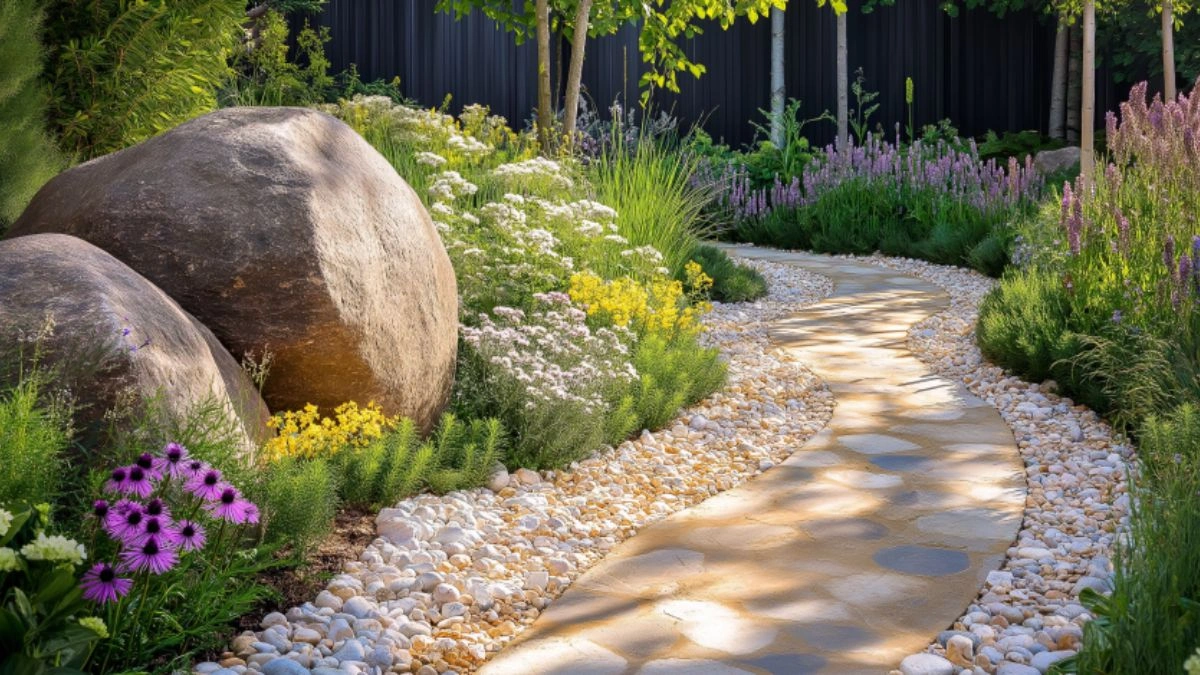Dry Creek Bed Walkway Ideas That Wow Guests
Table of Contents
Picture this: your guests step out into your garden and follow a beautifully winding stone path that mimics a natural creek, complete with rocks, plants, and an artful flow. Dry creek bed walkways are more than just practical—they are statement pieces in your landscape design.
Originally created to control drainage and prevent erosion, dry creek beds have evolved into aesthetic focal points that elevate outdoor spaces. Whether you’re dealing with a sloped yard, a bland stretch of lawn, or simply want to add a rustic touch to your garden, a dry creek bed walkway offers a visually striking and eco-friendly solution.
In this article, we’ll walk through creative dry creek bed walkway ideas that not only function well but also impress every guest who visits. From choosing materials and plants to adding lighting and designing curves, you’ll find inspiration for every style—natural, modern, minimalist, or woodland. Each section includes practical breakdowns, design visuals, and MidJourney prompts to help bring your vision to life.
Blending Form and Function in Dry Creek Bed Design
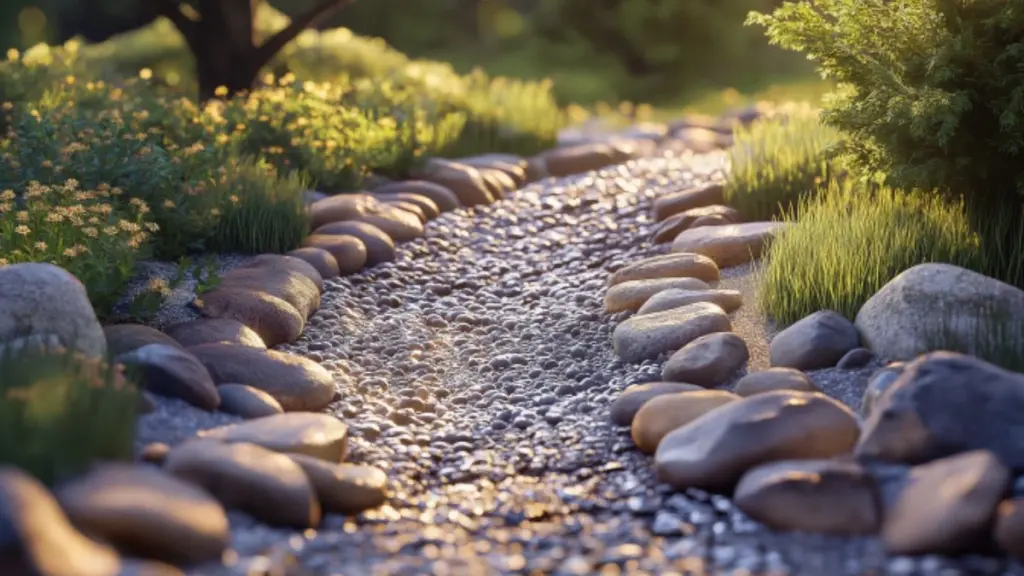
A dry creek bed walkway should look natural while solving real landscape issues. The key is balancing beauty with purpose.
To start, dry creek beds mimic the look of a stream but without water. They help direct rain runoff, control soil erosion, and add dimension to flat yards. These features are especially effective on sloped terrain where water might otherwise pool or cause damage.
Designing for functionality involves assessing how water moves through your yard. Then, you’ll layer stones, gravel, and edging to create that signature creek bed look—complete with dips, curves, and texture. A winding path enhances the illusion of a natural stream and provides a gentle, meandering walkway for guests.
Checklist: Functional Dry Creek Bed Basics
| Feature | Purpose |
|---|---|
| Channel shape | Mimics water flow; enhances realism |
| Larger rocks at edges | Helps hold shape and prevent erosion |
| Gravel bed | Improves drainage and walkability |
| Slope or grade | Supports water redirection |
Choosing the Right Rocks and Gravel for Visual Impact
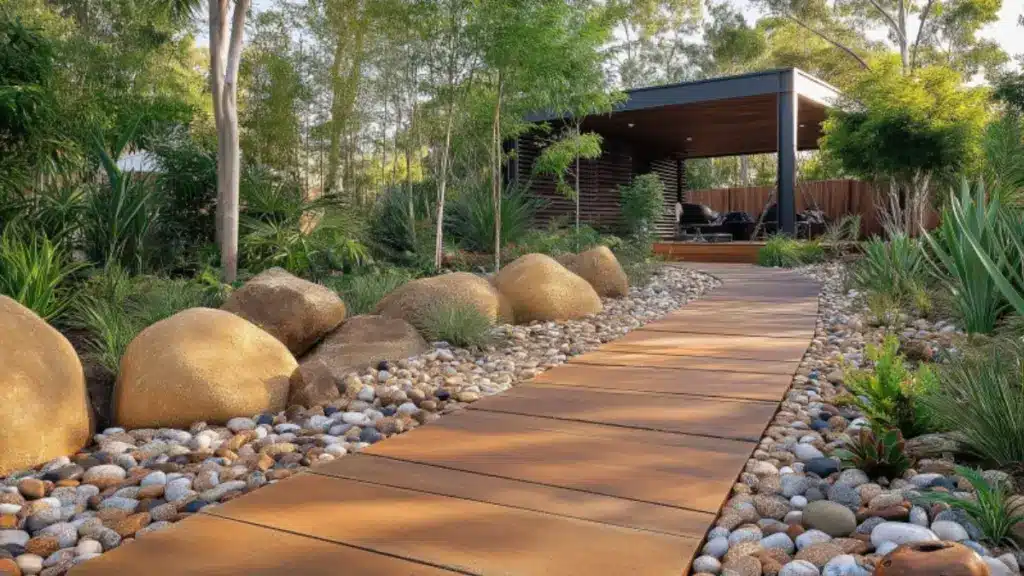
Stone selection can make or break your dry creek walkway. The right materials will evoke a sense of authenticity and blend beautifully with your surroundings.
Start with a mix of gravel, river rocks, and boulders. Gravel forms the “streambed,” offering a clean path underfoot. River rocks of varying sizes add dimension, while strategically placed boulders create visual weight and break up monotony.
Color also matters. Cool tones like gray and slate feel modern, while warm hues such as tan or rust evoke a desert or Mediterranean vibe. Don’t be afraid to mix shades, especially if your home has stone accents or earthy tones.
Table: Rock Types and Their Visual Effects
| Rock Type | Appearance | Best For |
|---|---|---|
| Pea Gravel | Small, rounded, neutral | Streambed base and drainage |
| River Rock | Smooth, varied sizes/colors | Edging and accenting curves |
| Flagstone | Flat, natural surface | Stepping stones within the bed |
| Boulders | Large, dramatic texture | Focal points and erosion control |
Incorporating Native Plants Along the Walkway
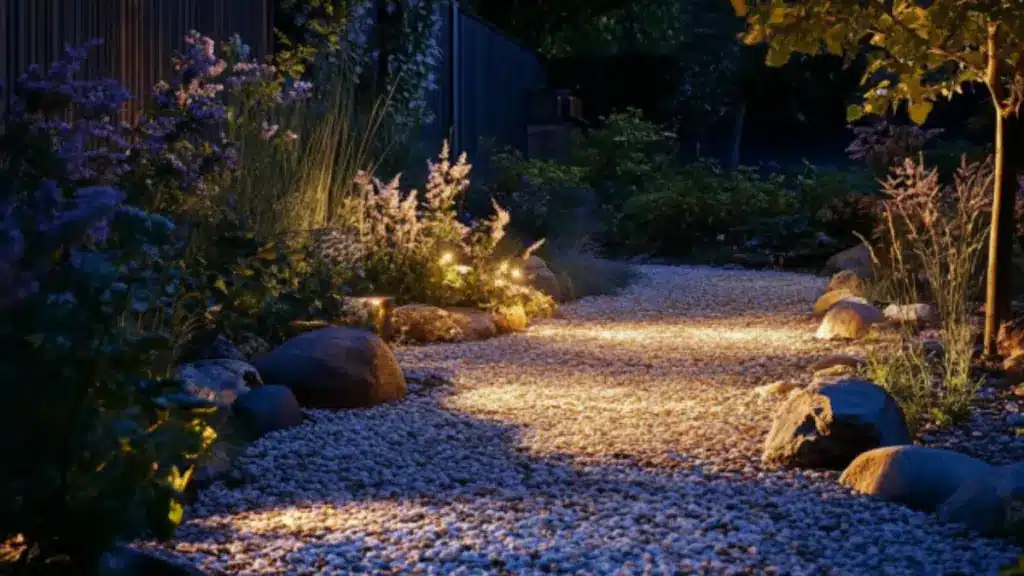
Plants are essential in softening the stony edges of your dry creek bed and giving it life—even without water. They also help anchor soil and reduce erosion.
Choose native or drought-tolerant plants to keep maintenance low. Ornamental grasses, succulents, lavender, and creeping ground covers look beautiful nestled among the rocks. You can also layer plants by height: groundcovers at the base, medium shrubs for fullness, and taller grasses or flowering perennials as accents.
Arrange them asymmetrically for a natural look—clusters here and there rather than in straight rows. This mimics how nature works, creating a wild, lush feeling.
Table: Top Plant Choices for Dry Creek Beds
| Plant Type | Examples | Benefits |
|---|---|---|
| Groundcovers | Creeping thyme, sedum | Fill gaps, prevent erosion |
| Grasses | Blue fescue, fountain grass | Add movement, drought-tolerant |
| Flowering plants | Lavender, yarrow, salvia | Color and seasonal interest |
| Shrubs | Dwarf juniper, barberry | Structure and contrast |
Creative Edging Techniques That Define the Path
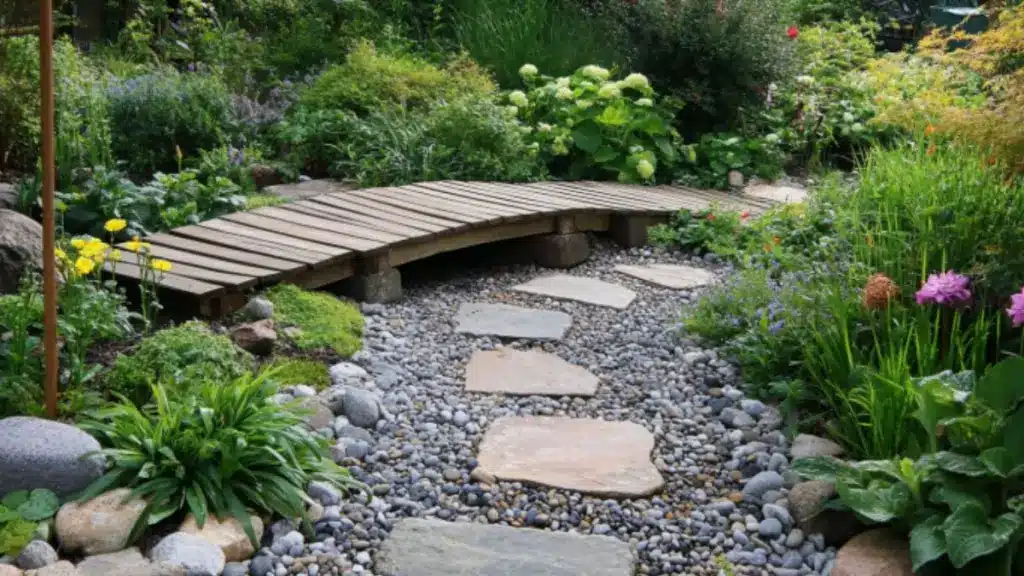
Edging your dry creek bed walkway gives it definition and prevents gravel from spilling into nearby lawn or garden areas. The trick is choosing an edging style that enhances rather than distracts.
Natural stone edging is a classic choice, blending seamlessly with the creek bed. You can also use steel, wood, or poured concrete for a more modern or structured feel. For a whimsical touch, try staggered log pieces or stacked broken terracotta.
Whatever you choose, edging defines the space visually and structurally, especially if the bed has gentle curves or slope changes.
Comparison Table: Edging Options
| Edging Material | Style Match | Durability | Best For |
|---|---|---|---|
| Natural stone | Rustic/Natural | High | Organic landscapes |
| Steel/metal | Modern/Minimal | Very high | Sleek and clean designs |
| Wood | Cottage/Whimsical | Moderate | Garden paths and budget builds |
| Concrete | Contemporary | High | Sharp edges, slope control |
Adding Stepping Stones or Bridges for Charm and Function
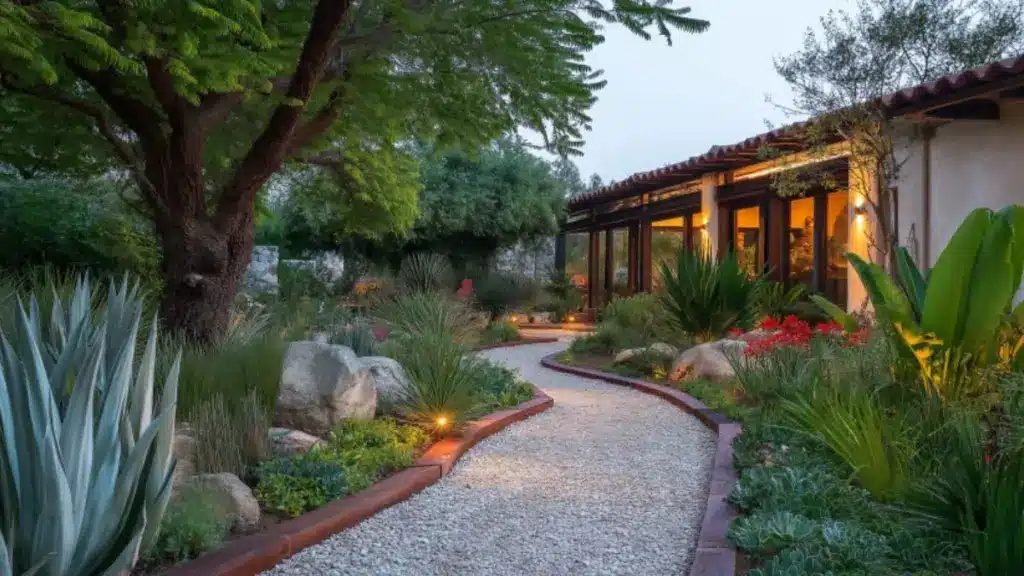
Adding stepping stones or small footbridges elevates both the form and function of a dry creek bed walkway. These features invite guests to interact with the landscape while enhancing its storybook appeal.
Use large flagstones or irregular pavers for a natural stepping path. Space them evenly for comfort, and nestle them slightly into the gravel. For larger spans, especially where your creek bed mimics a deeper channel, a small wooden bridge or arched stone pass can be both practical and charming.
Incorporating these elements also offers accessibility—guiding foot traffic without disturbing the surrounding plants or rockwork.
Visual Guide: Pathway Additions
| Feature | Function | Design Appeal |
|---|---|---|
| Stepping stones | Easy foot traffic | Rustic and natural |
| Wooden bridge | Spans wider beds or slopes | Storybook, cottagecore charm |
| Stone slab bridge | Seamless with the bed design | Elegant, timeless vibe |
Lighting Ideas to Highlight Your Walkway at Night
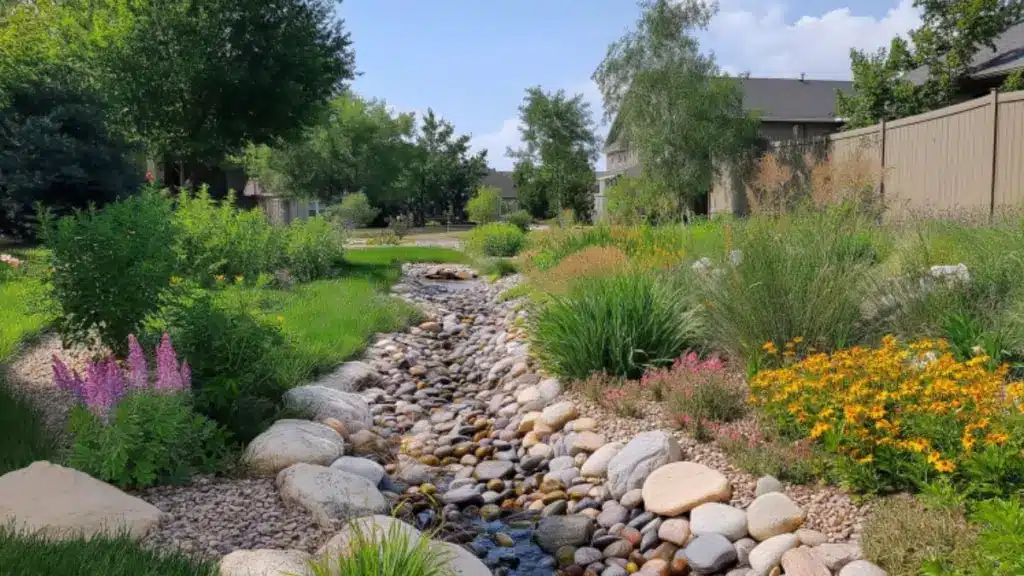
A dry creek bed can be just as stunning after sundown with the right lighting. Illuminating the path not only adds safety but also enhances ambiance.
Low-voltage landscape lighting is perfect for defining curves and highlighting features like boulders or bridges. Use stake lights along the edges, or install LED strips under bridge planks for a soft glow. Uplighting plants or spotlighting focal points like large rocks creates dramatic shadow play at night.
Choose warm-toned bulbs for a cozy, inviting look, and consider solar options for easy installation and sustainability.
Breakdown: Lighting for Dry Creek Beds
| Lighting Type | Placement | Purpose |
|---|---|---|
| Path/stake lights | Along walkway edges | Safe navigation and outline |
| Spotlights | On boulders or plants | Focal highlights |
| String lights | Overhead pergola | Whimsical garden effect |
| Solar uplights | Near plant clusters | Eco-friendly, soft landscape glow |
Designing Curves for Natural Flow
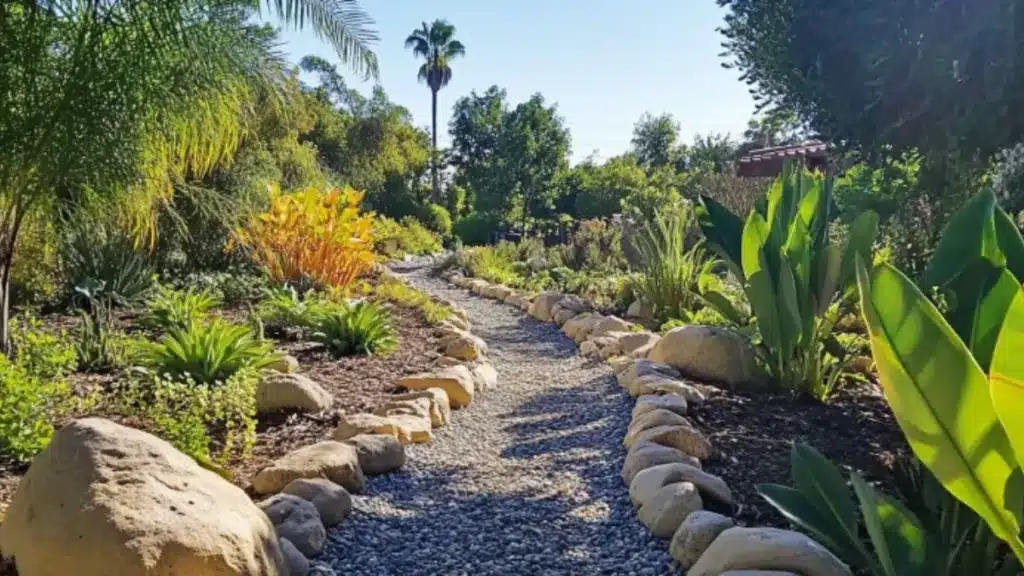
A common mistake in dry creek bed walkways is making them too straight. Natural creeks rarely run in straight lines—neither should your design.
Curved paths help slow down rainwater, aid drainage, and create a more dynamic visual experience. When guests walk a curved path, they discover new views with each step. Plus, curves give you space to add planting clusters, stepping stones, and lighting features without overcrowding.
To achieve a realistic curve:
- Start with a garden hose to outline the shape.
- Gradually widen and narrow the bed to simulate a meandering stream.
- Place larger rocks on the outer curves to anchor the flow visually.
Table: Curve Design Principles
| Curve Element | Effect on Design |
|---|---|
| Gentle turns | Natural movement and flow |
| Wider sections | Space for focal elements |
| Asymmetrical lines | Avoids artificial appearance |
Seasonal Maintenance Tips for Longevity
Once installed, a dry creek bed walkway requires minimal upkeep—but seasonal care ensures it stays beautiful year-round.
In spring, clear any debris that winter runoff may have left. Re-level gravel displaced by heavy rains, and check for any signs of erosion. Summer is a good time to prune overgrown plants and refresh mulch around plant bases.
Autumn brings falling leaves that can clog the streambed. Rake regularly and remove any buildup. In winter, although less maintenance is needed, check for pooling water or ice damage—especially if you live in a freeze-thaw zone.
Seasonal Maintenance Calendar
| Season | Task |
|---|---|
| Spring | Clean debris, re-level gravel |
| Summer | Prune plants, check edging stability |
| Autumn | Rake leaves, inspect runoff flow |
| Winter | Monitor for freeze damage |
Conclusion
Dry creek bed walkways are more than a landscaping trend—they are a way to turn everyday yards into immersive garden experiences. Whether you use them to manage drainage, guide foot traffic, or simply add beauty, their blend of form and function makes them a standout choice in outdoor design.
With careful material selection, natural curves, thoughtful planting, and subtle lighting, your walkway becomes a journey your guests won’t forget. By incorporating seasonal maintenance and design details, it will continue to charm and impress year after year.
Let your landscape tell a story—one rock, one curve, one flower at a time.

